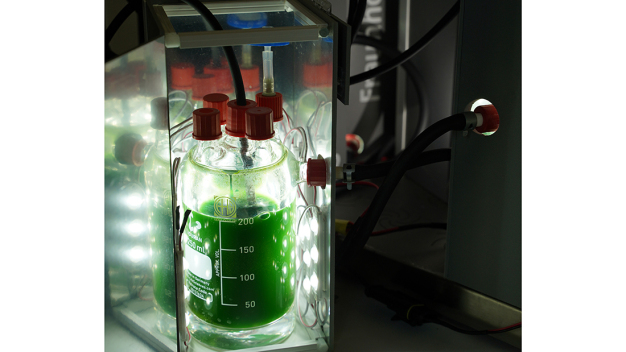- Science
Development of bio-based, climate-neutral building materials by means of biogenic material production using phototrophic microorganisms
Based on an industry-oriented competence portfolio, the Fraunhofer Institute for Electron Beam and Plasma Technology FEP in Dresden offers a broad spectrum of scalable research and development opportunities. Our mission is to apply our technological innovation potential for novel production processes and to harness it to meet society's need for resource conservation and climate neutrality. Considering the growing demand for climate-neutral building materials, new manufacturing processes are also being sought in the construction sector. The Fraunhofer FEP is conducting research into innovative electron beam-assisted processes for increased biogenic limestone synthesis using phototrophic microorganisms in order to support the decarbonization of the cement industry. In this way, the CO2 footprint of cement formulations can be further reduced in the future and fossil limestone can be gradually replaced as a primary resource. This research project will be presented at the BAU 2025 trade fair in Munich, from January 13 – 17, 2025, at the joint booth of Fraunhofer in hall C2, booth no. 528.
Due to the close links between Fraunhofer FEP and industry, the results of applied research are transferred into a wide range of applications and products. A particular focus is directed on the strategic research fields of sustainability, life science and environmental technologies, and in application fields such as the construction sector and smart buildings. In particular, low-energy, non-thermal electron beam technology is a multifunctional tool with omnipotent potential for use in a wide range of environmental and biotechnological applications and can be integrated into existing production lines. Due to growing demands for sustainable and resource-saving processes and to achieve climate targets, the need for bio-based substitution processes in the construction sector is also growing. For ecologically relevant issues, such as the biotechnological extraction of resources, the scientists at Fraunhofer FEP can utilize the chemical and biological effects of low-energy accelerated electrons for application-specific process development.
Germany has set itself the ambitious goal of achieving climate neutrality by 2045 and reducing greenhouse gas emissions under the Climate Protection Act, which represents an enormous challenge for the industry. The construction sector is one of the world's largest economic sectors, which is why climate-neutral and circular construction of the future will require a wide range of transformations. The development of new bio-based and sustainable materials to permanently capture CO2 is a starting point for research and development that project manager Dr. Ulla König is working on in her Biocompatible Materials group at the Fraunhofer FEP.
Cement, the world's most widely produced material, is indispensable as a binding agent in the construction industry, with global cement consumption continuing to rise due to population growth, urbanization and increasing infrastructure development. The cement industry is a major source of greenhouse gas emissions, which is why climate neutrality in this sector can only be achieved through alternative approaches. Decarbonization is therefore a promising strategy in which the development of CO2-reduced cements will be an essential task.
At Fraunhofer FEP, researchers in the Biocompatible Materials Group, in cooperation with the institute's own biomedical service laboratory, are conducting intensive research into the biogenic material development of secondary limestone using phototrophic microorganisms that consume CO2. These are able to fix and convert carbon dioxide from the atmosphere through photosynthesis. The focus of the research is to be able to implement the process of microbiological limestone formation, which has existed in nature for billions of years, on an industrial scale and to improve its productivity so that low-emission building materials can be produced in later stages that permanently capture CO2 and thus make a sustainable contribution to the circular economy.
Group manager Dr. Ulla König explains: “The optimization and scalability of biogenic limestone synthesis based on the microbial biomineralization process plays a key role for future large-scale applications. At Fraunhofer FEP, we have therefore combined the optimization of the biomineralization of phototrophic microorganisms with a novel approach. To this end, we utilize the biostimulating potential of electron beam technology. We are tapping into the dose-dependent biopositive effect of low-energy, non-thermal electron beam processes on the metabolic processes of phototrophic microorganisms in order to increase the effectiveness and efficiency of biogenic limestone synthesis.”
As part of collaborations, circular manufacturing processes can then be developed in the next stage of development, including the recycling of waste and residual materials to create sustainable, bio-based building and construction materials. At the BAU 2025 trade fair in Munich from January 13 – 17, 2025, the scientists will present these new research approaches and other perspectives at the joint Fraunhofer stand and will be available for discussions on joint project ideas and research projects.
Fraunhofer-Institut für Elektronenstrahl- und Plasmatechnik FEP
01277 Dresden
Germany










